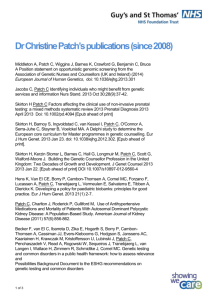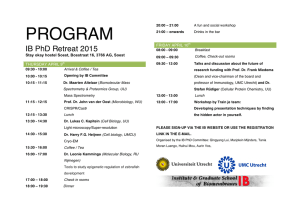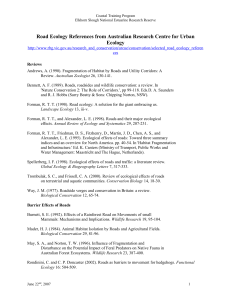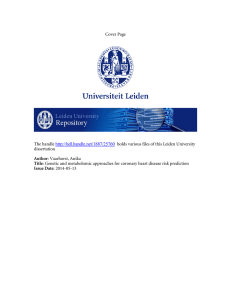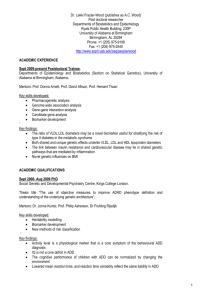MEC_3971_sm_AppendixS2
advertisement
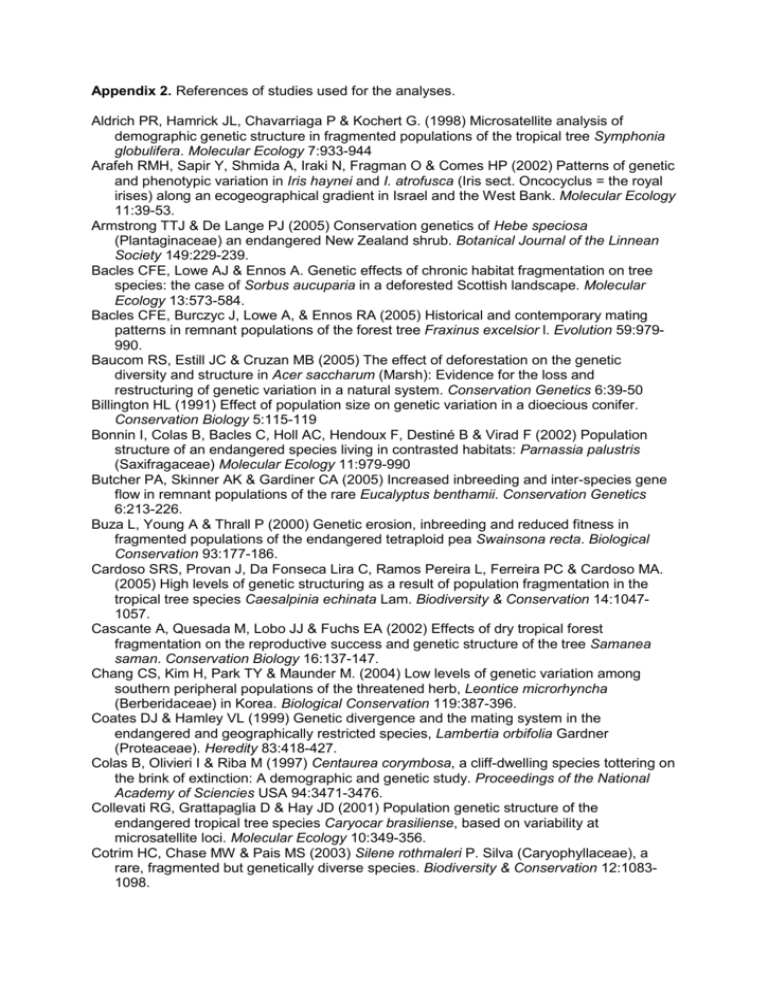
Appendix 2. References of studies used for the analyses. Aldrich PR, Hamrick JL, Chavarriaga P & Kochert G. (1998) Microsatellite analysis of demographic genetic structure in fragmented populations of the tropical tree Symphonia globulifera. Molecular Ecology 7:933-944 Arafeh RMH, Sapir Y, Shmida A, Iraki N, Fragman O & Comes HP (2002) Patterns of genetic and phenotypic variation in Iris haynei and I. atrofusca (Iris sect. Oncocyclus = the royal irises) along an ecogeographical gradient in Israel and the West Bank. Molecular Ecology 11:39-53. Armstrong TTJ & De Lange PJ (2005) Conservation genetics of Hebe speciosa (Plantaginaceae) an endangered New Zealand shrub. Botanical Journal of the Linnean Society 149:229-239. Bacles CFE, Lowe AJ & Ennos A. Genetic effects of chronic habitat fragmentation on tree species: the case of Sorbus aucuparia in a deforested Scottish landscape. Molecular Ecology 13:573-584. Bacles CFE, Burczyc J, Lowe A, & Ennos RA (2005) Historical and contemporary mating patterns in remnant populations of the forest tree Fraxinus excelsior l. Evolution 59:979990. Baucom RS, Estill JC & Cruzan MB (2005) The effect of deforestation on the genetic diversity and structure in Acer saccharum (Marsh): Evidence for the loss and restructuring of genetic variation in a natural system. Conservation Genetics 6:39-50 Billington HL (1991) Effect of population size on genetic variation in a dioecious conifer. Conservation Biology 5:115-119 Bonnin I, Colas B, Bacles C, Holl AC, Hendoux F, Destiné B & Virad F (2002) Population structure of an endangered species living in contrasted habitats: Parnassia palustris (Saxifragaceae) Molecular Ecology 11:979-990 Butcher PA, Skinner AK & Gardiner CA (2005) Increased inbreeding and inter-species gene flow in remnant populations of the rare Eucalyptus benthamii. Conservation Genetics 6:213-226. Buza L, Young A & Thrall P (2000) Genetic erosion, inbreeding and reduced fitness in fragmented populations of the endangered tetraploid pea Swainsona recta. Biological Conservation 93:177-186. Cardoso SRS, Provan J, Da Fonseca Lira C, Ramos Pereira L, Ferreira PC & Cardoso MA. (2005) High levels of genetic structuring as a result of population fragmentation in the tropical tree species Caesalpinia echinata Lam. Biodiversity & Conservation 14:10471057. Cascante A, Quesada M, Lobo JJ & Fuchs EA (2002) Effects of dry tropical forest fragmentation on the reproductive success and genetic structure of the tree Samanea saman. Conservation Biology 16:137-147. Chang CS, Kim H, Park TY & Maunder M. (2004) Low levels of genetic variation among southern peripheral populations of the threatened herb, Leontice microrhyncha (Berberidaceae) in Korea. Biological Conservation 119:387-396. Coates DJ & Hamley VL (1999) Genetic divergence and the mating system in the endangered and geographically restricted species, Lambertia orbifolia Gardner (Proteaceae). Heredity 83:418-427. Colas B, Olivieri I & Riba M (1997) Centaurea corymbosa, a cliff-dwelling species tottering on the brink of extinction: A demographic and genetic study. Proceedings of the National Academy of Sciencies USA 94:3471-3476. Collevati RG, Grattapaglia D & Hay JD (2001) Population genetic structure of the endangered tropical tree species Caryocar brasiliense, based on variability at microsatellite loci. Molecular Ecology 10:349-356. Cotrim HC, Chase MW & Pais MS (2003) Silene rothmaleri P. Silva (Caryophyllaceae), a rare, fragmented but genetically diverse species. Biodiversity & Conservation 12:10831098. Cozzolino S, Noce ME, Musacchio A & Widmer A (2003) Variation at a chloroplast minisatellite locus reveals the signature of habitat fragmentation and genetic bottlenecks in the rare orchid Anacamptis palustris (Orchidaceae). American Journal of Botany 90:1681-1687. Cruzan MB (2001) Population size and fragmentation thresholds for the maintenance of genetic diversity in the herbaceous endemic Scutellaria montana (Lamiaceae). Evolution 55:1569-1580. Cuartas-Hernandez & Nuñez-Farfan (2006) The genetic structure of the tropical understory herb Dieffenbachia seguine L. before and after forest fragmentation. Evolutionary Ecology Research 8:1061-1075. Culley TM & Grubb TC (2003) Genetic effects of habitat fragmentation in Viola pubescens (Violaceae), a perennial herb with chasmogamous and cleistogamous flowers. Molecular Ecology 12:2919-2930. Dayanandan S, Dole J, Bawa K & Kesseli R (1999) Population structure delineated with microsatellite markers in fragmented populations of a tropical tree, Carapa guianensis (Meliaceae). Molecular Ecology 8:1585-1592. Dick CW, Etchelecu G & Austerlitz F (2003) Pollen dispersal of tropical trees (Dinizia excelsa: Fabaceae) by native insects and African honeybees in pristine and fragmented Amazonian rainforest. Molecular Ecology 12:753-764. Ditbrenner A, Hensen I & Wesche K (2005) Genetic structure and random amplified polymorphic DNA diversity of the rapidly declining Angelica palustris (Apiaceae) in Eastern Germany in relation to population size and seed production. Plant Species Biology 20:191-200. Dolan RW (1994) Patterns of isozyme variation in relation to population size, isolation, and phytogeographic history in royal catchfly (Silene regia; Caryophyllaceae). American Journal of Botany 81:965-972. Doligez A & Joly HI (1997) Mating system of Carapa procera (Meliaceae) in the French Guiana tropical forest. American Journal of Botany 84:461-470. England PR, Usher AV, Whelan RJ & Ayre DJ (2002) Microsatellite diversity and genetic structure of fragmented populations of the rare, fire-dependent shrub Grevillea macleayana. Molecular Ecology 11:967-977. Fernandez JF & Sork VL (2005) Mating Patterns of a Subdivided Population of the Andean Oak (Quercus humboldtii Bonpl., Fagaceae). Journal of Heredity 96:635-643. Fischer M & Matthies D (1998) RAPD variation in relation to population size and plant fitness in the rare Gentianella germanica (Gentianaceae). American Journal of Botany 85:811819. Fischer M, Husi R, Prati D, Peintinger M, Van Kleulen M & Schmid B (2000) RAPD variation among and within small and large populations of the rare clonal plant Ranunculus reptans (Ranunculaceae). American Journal of Botany 87:1128-1137. Fusch EJ, Lobo JA & Quesada M (2003) Effects of forest fragmentation and flowering phenology on the reproductive success and mating patterns of the tropical dry forest tree Pachira quinata. Conservation Biology 17:149-157. Galeuchet DJ, Perret C & Fischer M (2005) Microsatellite variation and structure of 28 populations of the common wetland plant, Lychnis flos-cuculi L., in a fragmented landscape. Molecular Ecology 14:991-1000. Godt MJW & Hamrick JL (1998) Allozyme diversity in the endangered pitcher plant Sarracenia rubra ssp. alabamensis (Sarraceniaceae) and its close relative S. rubra ssp. rubra. American Journal of Botany 85:802-810. Godt MJW, Johnson BR & Hamrick JL (1996) Genetic diversity and population size in four rare Southern Appalachian plant species. Conservation Biology 10:796-805. Gonzales E & Hamrick JL (2005) Distribution of genetic diversity among disjunct populations of the rare forest understory herb, Trillium reliquum. Heredity 95:306-314. Gustafson DJ, Gibson DJ & Nickrent DL (2004) Conservation genetics of two co-dominant grass species in an endangered grassland ecosystem. Journal of Applied Ecology 41:389-397. Gustafsson S (2000) Patterns of genetic variation in Gymnadenia conopsea, the fragrant orchid. Molecular Ecology 9:1863-1872. Hall P, Orrell LC & KS Bawa (1994) Genetic diversity and mating system in a tropical tree, Carapa guianensis (Meliaceae). American Journal of Botany 81:1104-1111. Hall P, Chase MR & Bawa KS (1994) Low genetic variation but high population differentiation in a common tropical forest tree species. Conservation Biology 8:471-482. Hall P, Walker S & Bawa KS (1996) Effect of forest fragmentation on genetic diversity and mating system in a tropical tree, Pithecellobium elegans. Conservation Biology 10:757768 Hensen I & Oberprieler C (2005) Effects of population size on genetic diversity and seed production in the rare Dictamnus albus (Rutaceae) in central Germany. Conservation Genetics 6:63-73. Herrerías-Diego Y. (2006) PhD Thesis. Effects of tropical dry forest fragmentation on the reproductive success, seed predation and genetic structure of Ceiba aesculifolia HBK (Bombacaceae). UNAM, Doctorado en Ciencias Biológicas. Heuertz M, Vekemans X, Hausman JF, Palada M & Hardy OJ (2003) Estimating seed vs. pollen dispersal from spatial genetic structure in the common ash. Molecular Ecology 12:2483-2495. Hilfiker K, Gugerli F, Schütz JP, Rotach P & Holderegger R (2004) Low RAPD variation and female-biased sex ratio indicate genetic drift in small populations of the dioecious conifer Taxus baccata in Switzerland. Conservation Genetics 5:357-365. Honnay O, Coart E, Butaye J, Adriaens D, Van Glabeke S & Roldán-Ruiz I (2006) Low impact of present and historical landscape configuration on the genetics of fragmented Anthyllis vulneraria populations. Biological Conservation 127:411-419. Honnay O, Jacquemyn H, Roldán-Ruiz I & Hermy M (2006) Consequences of prolonged clonal growth on local and regional genetic structure and fruiting success of the forest perennial Maianthemum bifolium. Oikos 112:21-30. Honnay O, Adriaens D., Coart E., Jacquemyn H, & Roldán-Ruiz I (2007) Genetic diversity within and between remnant populations of the endangered calcareous grassland plant Globularia bisnagarica L. Conservation Genetics 8:293-303. Hooftman DA, Billeter RC, Schmid B & Diemer M (2004) Genetic effects of habitat fragmentation on common species of Swiss fen meadows. Conservation Biology 18:1043-1051. Jacquemyn H, Honnay O, Galbusera P, Roldán-Ruiz I (2004) Genetic structure of the forest herb Primula elatior in a changing landscape. Molecular Ecology 13:211-219. Jacquemyn H, Brys R, Honnay O, Hermy M, Roldán-Ruiz I (2006) Sexual reproduction, clonal diversity and genetic differentiation in patchily distributed populations of the temperate forest herb Paris quadrifolia (Trilliaceae). Oecologia 147:434-444. Julio NB, Sobral A, Rondan Dueñas J, Di Rienzo J, Renison D, Hensen I (2008) RAPD and ISSR markers indicate diminished gene flow due to recent fragmentation of Polylepis australis woodlands in central Argentina. Biochemical, Systematics and Ecology 36: 329335. Jump AS & Pañuelas J (2006) Genetic effects of chronic habitat fragmentation in a windpollinated tree. Proceedings of the National Acadedmy of Sciences USA 103:8096-8100. Kettle CJ, Hollingsworth M, Jaffre T, Moran B & Ennos RA (2007) Identifying the early genetic consequences of habitat degradation in a highly threatened tropical conifer, Araucaria nemorosa Laubenfels. Molecular Ecology 16:3581-3591. Kreivi M, Rautiainen P, Aspi J & Hyvärinen M (2005) Genetic structure and gene flow in an endangered perennial grass, Arctophila fulva var. pendulina. Conservation Genetics 6:683-696. Lammi A, Siikamäki P & Mustajärvi K (1999) Genetic diversity, population size, and fitness in central and peripheral populations of a rare plant Lychnis viscaria. Conservation Biology 13:1069-1078. Lee SL (2000) Mating system parameters of Dryobalanops aromatica Gaertn. f. (Dipterocarpaceae) in three different forest types and a seed orchard. Heredity 85:338345. Lienert J, Fischer M, Schneller J & Diemer M (2002) Isozyme variability of the wetland specialist Swertia perennis (Gentianaceae) in relation to habitat size, isolation, and plant fitness. American Journal of Botany 89:801-811. Llorens TM, Ayre DJ & Whelan RJ (2004) Evidence for ancient genetic subdivision among recently fragmented populations of the endangered shrub Grevillea caleyi (Proteaceae). Heredity 92:519-526. Lönn M & Prentice HC (2002) Gene diversity and demographic turnover in central and peripheral populations of the perennial herb Gypsophila fastigiata. Oikos 99:489-498. López-Pujol J, Orellana MR, Bosch M, Simon J & Blanché C (2003) Effects of habitat fragmentation on allozyme diversity and conservation status of the coastal sand dune plant Stachys maritima (Lamiaceae) in the Iberian peninsula. Plant Biology 5: 504-512. López-Pujol J, Zhang FM & Ge S (2005) Population genetics and conservation of the critically endangered Clematis acerifolia (Ranunculaceae). Canadian Journal of Botany 83:1248-1256. López-Pujol J, Font J, Simon J, César Blanché (2007) Can the preservation of historical relicts permit the conservation of endangered plant species? The case of Silene sennenii (Caryophyllaceae). Conservation Genetics 8:903-912. Luijten SH, Dierick A, Oostermeijer JGB, Raijmann LE & den Nijs HCM (2000). Population size, genetic variation, and reproductive success in a rapidly declining, self-incompatible perennial (Arnica montana) in the Netherlands. Conservation Biology 14: 1776-1787. Maki M, Masuda M & Inoue K (1996) Genetic diversity and hierarchical population structure of a rare autotetraploid plant, Aster kantoensis (Asteraceae). American Journal of Botany 83:296-303. Mathiasen P, Rovere AE & Premoli AC (2007) Genetic structure and early effects of inbreeding in fragmented temperate forests of a self-Incompatible tree, Embothrium coccineum. Conservation Biology 21:232-240. Matolweni LO, Balkwill K, McLellan T (2000) Genetic diversity and gene flow in the morphologically variable, rare endemics Begonia dregei and Begonia homonyma (Begoniaceae). American Journal of Botany 87:431-439. Murawski DA, Gunatilleke IAU & Bawa KS (1994) The effects of selective logging on inbreeding in Shorea megistophylla (Dipterocarpaceae) from Sri Lanka. Conservation Biology 8:997-1002. Murren CJ (2003) Spatial and demographic population genetic structure in Catasetum viridiflavum across a human-disturbed habitat. Journal of Evolutionary Biology 16:333342. Neel MC & Ellstrand NC (2001) Patterns of allozyme diversity in the threatened plant Erigeron parishii (Asteraceae) American Journal of Botany 88:810-818. Neel MC & Ellstrand NC (2003) Conservation of genetic diversity in the endangered plant Eriogonum ovalifolium var. vineum (Polygonaceae). Conservation Genetics 4:337-352. Novick RR, Dick CW, Lemes MR, Navarro C, Caccone A & Bermingham E (2003) Genetic structure of Mesoamerican populations of Big-leaf mahogany (Swietenia macrophylla) inferred from microsatellite análisis. Molecular Ecology 12:2885-2893. Obayashi K, Tsumura Y, Ihara-Ujino T, Niiyama K, Tanouchi H, Suyama Y, Washitani I, Lee CT, Lee SL & Mamad N (2002) Genetic diversity and outcrossing rate between undisturbed and selectively logged forests of Shorea curtisii (Dipterocarpaceae) using microsatellite DNA análisis. International Journal of Plant Research 163:151-158. O’connell LM, Mosseler A & Rajora OP (2006) Impacts of forest fragmentation on the mating system and genetic diversity of white spruce (Picea glauca) at the landscape level. Heredity 97:418-426. Oostermeijer JGB & De Knegt B (2004) Genetic population structure of the wind-pollinated, dioecious shrub Juniperus communis in fragmented Dutch heathlands. Plant Species Biology 19:175-184. Paschke M, Abs C & Schmid B (2002) Relationship between population size, allozyme variation, and plant performance in the narrow endemic Cochlearia bavarica. Conservation Genetics 3:131-144. Pluess AR & Stöcklin J (2004) Genetic diversity and fitness in Scabiosa columbaria in the Swiss Jura in relation to population size. Conservation Genetics 5:145-156. Podolski RH (2001) Genetic variation for morphological and allozyme variation in relation to population size in Clarkia dudleyana, an endemic annual. Conservation Biology 15:412423. Prentice HC, Lönn M, Rosquist G, Ihse M & Kindström M (2006) Gene diversity in a fragmented population of Briza media: grassland continuity in a landscape context. Journal of Ecology 94:87-97. Prober SM & Brown AHD (1994) Conservation of the grassy white box woodlands: population genetics and fragmentation of Eucalyptus albens. Conservation Biology 8:1003-1013. Prober SM, Spindler LH & Brown AHD (1998) Conservation of the grassy white box woodlands: effects of remnant population size on genetic diversity in the allotetraploid herb Microseris lanceolata. Conservation Biology 12:1279-1290. Quesada M, Stoner KE, Lobo JA, Herrerías-Diego Y, Palacios-Guevara C, Mungía-Rosas MA, Salazar KA & Rosas-Guerrero V (2004). Effects of forest fragmentation on pollinator activity and consequences for plant reproductive success and mating patterns in bat pollinated bombacaceous trees. Biotropica 36:131-138. Raijmann LEL, Van Leeuwen NC, Kersten R, Oostermeijer JGB, Den Nijs HCM, Menken SBJ (1994) Genetic variation and outcrossing rate in relation to population size in Gentiana pneumonanthe L. Conservation Biology 8:1014-1026. Raspé O & Jacquemart AL (1998) Allozyme diversity and genetic structure of European populations of Sorbus aucuparia L. (Rosaceae: Maloideae). Heredity 81:537-545. Rocha OJ & Aguilar G (2001) Reproductive biology of the dry forest tree Enterolobium cyclocarpum (Guanacaste) in Costa Rica: A comparison between trees left in pastures and trees in continuous forest. American Journal of Botany 88:1607-1614. Schiemann K, Tyler T & Widén B (2000) Allozyme diversity in relation to geographic distribution and population size in Lathyrus vernus (L.) Bernh. (Fabaceae). Plant Systematics and Evolution 225:119-132. Schmidt K & Jensen K (2000) Genetic structure and AFLP variation of remnant populations in the rare plant Pedicularis palustris (Scrophulariaceae) and its relation to population size and reproductive components. American Journal of Botany 87:678-689. Starr GJ & Carthew SM (1989) Genetic differentiation in isolated populations of Hakea carinata (Proteaceae). Australian Journal of Botany 46:671-682. Tomimatsu H & Ohara M (2003) Genetic diversity and local population structure of fragmented populations of Trillium camschatcense (Trilliaceae). Biological Conservation 109:249-258. Van Rossum F, Echchgadda G, Szabadi I & Triest L (2002) Commonness and long-term survival in fragmented habitats: Primula elatior as a study case. Conservation Biology 16:1286-1295. Van Rossum F & Prentice HC (2004) Structure of allozyme variation in Nordic Silene nutans (Caryophyllaceae): population size, geographical position and immigration history. Biological Journal of the Linnean Society 81:357-371. Van Rossum F, Campos de Sousa S & Triest L (2004) Genetic consequences of habitat fragmentation in an agricultural landscape on the common Primula veris, and comparison with its rare congener, P. vulgaris. Conservation Genetics 5:231-245. Vergeer P, Rengelink R, Ouborg NJ & Roelofs JGM (2003) Effects of population size and genetic variation on the response of Succisa pratensis to eutrophication and acidification. Journal of Ecology 91:600-609. Van Treuren R, Bijlsma R, Van Delden W & Ouborg NJ (1991) The significance of genetic erosion in the process of extinction. I. Genetic differentiation in Salvia pratensis and Scabiosa columbaria in relation to population size. Heredity 66:181-189. Weidema IR, Siegismund HR & Philipp M (1996) Distribution of genetic variation within and among Danish populations of Armeria maritima, with special reference to the effects of population size. Hereditas 124:121-129. Weidema IR, Magnussen LS & Philipp M (2000) Gene flow and mode of pollination in a drygrassland species, Filipendula vulgaris (Rosaceae). Heredity 84:311-320. White GM, Boshier DH & Powell W (1999) Genetic variation within a fragmented population of Swietenia humilis Zucc. Molecular Ecology 8:1899-1909. Wolf AT, Howe RW & Hamrick JL (2000) Genetic diversity and population structure of the serpentine endemic Calystegia collina (Convolvulaceae) in Northern California. American Journal of Botany 87:1138-1146. Wolf AT, Harrison SP & Hamrick JL (2000) Influence of habitat patchiness on genetic diversity and spatial structure of a serpentine endemic plant. Conservation Biology 14:454-463. Yao X, Ye Q, Kang M & Huang H (2007) Microsatellite analysis reveals interpopulation differentiation and gene flow in the endangered tree Changiostyrax dolichocarpa (Styracaceae) with fragmented distribution in central China. New Phytologist 176:472480. Young et al. (1999) Genetic structure of fragmented populations of the endangered daisy Rutidosis leptorrhynchoides. Conservation Biology 13:256-265. Zhao AL, Chen XY, Zhang X & Zhang D. (2006) Effects of fragmentation of evergreen broadleaved forests on genetic diversity of Ardisia crenata var. bicolor (Myrsinaceae). Biodiversity & Conservation 15:1339-1351.
